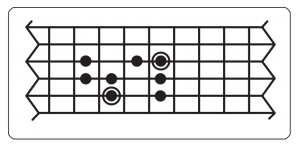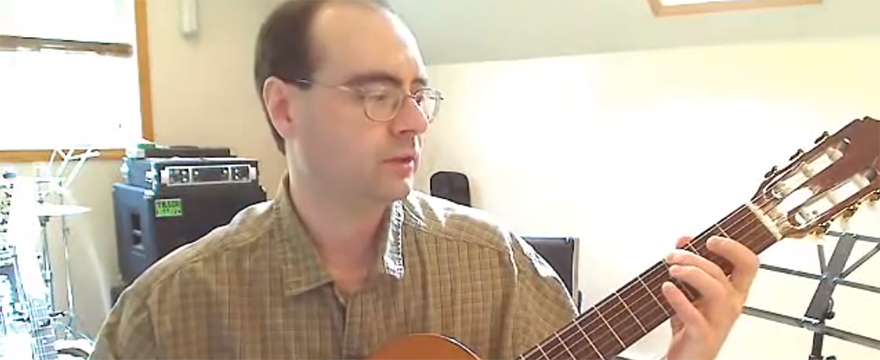Scales on string instruments are studied and used differently compared to other musical instruments. The neck layout of the guitar along with the strings form a “grid.” From this vertical and horizontal (grid) layout we achieve a way to establish scales as geometrical pattrens. This lesson explains how scales work on guitar by comparing guitar scales to piano scales as well as, breaking down a number of “guitar-specific” scale concepts…
Q: How Do Scales Work on the Guitar?
About a year ago, I began studying guitar after playing piano for six years. I was wondering if you could quickly explain how scales work on the guitar, because I am finding it quite different compared to the piano.
~ Shannon
A: There are certainly some differences between how we organize scales on a piano as compared to how we organize scales on a guitar.
GUITAR SCALES:
When it comes to scales on guitar, and scales on a piano, the main difference is how a guitar player views each scale pattern as a geometrical shape along and across the neck.
The guitar neck can be thought of as a vertical and horizontal grid, with the scale shapes laid out across the grid based upon each scales Tonic /Root notes.
The fingerboard contains repeating tones called, “unison tones,” (the exact same note located in another place on the neck). And, the range of a scale is based upon “Octaves,” (the same letter name 8-tones higher).
Scale geometry combines octaves with up to 4 unison tones (for some scale tones), creating a visual or “pattern” oriented approach for the guitarist when learning about scales applied onto the guitar neck.
The diagram below shows how the exact same (unison tone) of “C” can be located in four separate areas of the guitar fingerboard…

The diagram below shows how octaves can be established across the fingerboard using a “C” tone…

PIANO SCALES:
Piano players view scales as specific note names and every note name has a note location on the keyboard for each scale tone. All tones are reserved for only one place upon the piano keyboard. On piano there are no unison tones.
NOTE: Piano players tend to be slightly better with their general theory for key signatures much earlier on than guitar players. This is due to how they get to know their keyboard note names earlier through the piano method of scale practice.
When a guitarist learns a scale it is commonly viewed by the guitar player as nothing more than a geometrical pattern on the guitar fingerboard. But, when a piano player learns a scale it is a series of scale tones, (C, D, E, F, G, A, B, C).
The piano player learns a fingering pattern for every scale /key signature, but the guitarist learns shapes that relate to scale quality, (major or minor). On a guitar, the quality of the scale pattern can relocate to the position that is required for the key.
GUITAR SCALE PATTERNS:
The guitar neck and strings operate together as a vertical and horizontal grid system for the layout of all of the guitar’s scale shapes, (this includes all scales, i.e., Major, Minor, Blues, Modes, etc.).
The layouts for each and every guitar scale possible in music are all done using a series of geometrical patterns, (similar to how guitarists learn their chords).
For example, a “C Major” scale on guitar is not just a “C” scale of the major quality. Instead, we view the shape of the scale as a “Major Scale Pattern” that can be placed anywhere along the guitar’s fingerboard.
In other words, the “shape” of the scale is actually more relevant to a guitar player than the fact it is rooted upon the note “C.”
The “C” Major Scale:
in position as note (letter) names

The “Major Scale” Pattern:
note locations as the ‘universal’ 5th-string root pattern (for any key /major scale)

LEARNING THE NOTES:
A common issue faced by many practicing guitar students is a lack of knowledge for note names and note locations across the guitar fingerboard. This is largely due to how guitar players learn scales.
As shown in the scale and pattern diagrams above, guitar students study scales as geometrical shapes and tend to forego the scale-tone names.
This is why learning to read traditional music note reading can be so valuable for guitar players.
NOTE: Traditional music notation, (not TAB), is one of the best ways available to be able to learn all of the notes across the guitar neck.
CONCLUSION:
Learning scale patterns on the guitar neck is a different process than learning all of the note names on the neck. For the guitarist, scales are shapes – not notes.
When guitarists learn scale patterns, the shapes are analyzed from the scale patterns Tonic, (the scales naming note). The way that each note of the scale sits upon the neck is related to intervals and those interval designs will determine the quality of the shape (quality refers to whether the scale is major or minor).
One of the best ways that a guitar student can begin the process of learning their scales on the neck is to start by learning, “Octave Patterns.” This is often referred to as the, “CAGED Theory.”
Once the octave patterns have been memorized, scale shapes for each key signature can then be practiced off of every keys specific Tonic /Root note. The octave patterns are covered in detail within the content of the Creative Guitar Studio, “Intermediate Guitar Program.” Scales are covered in the “Advanced Guitar Program.”
- Click the button below to download the lesson handout
(access to lesson material will require a FREE membership)
